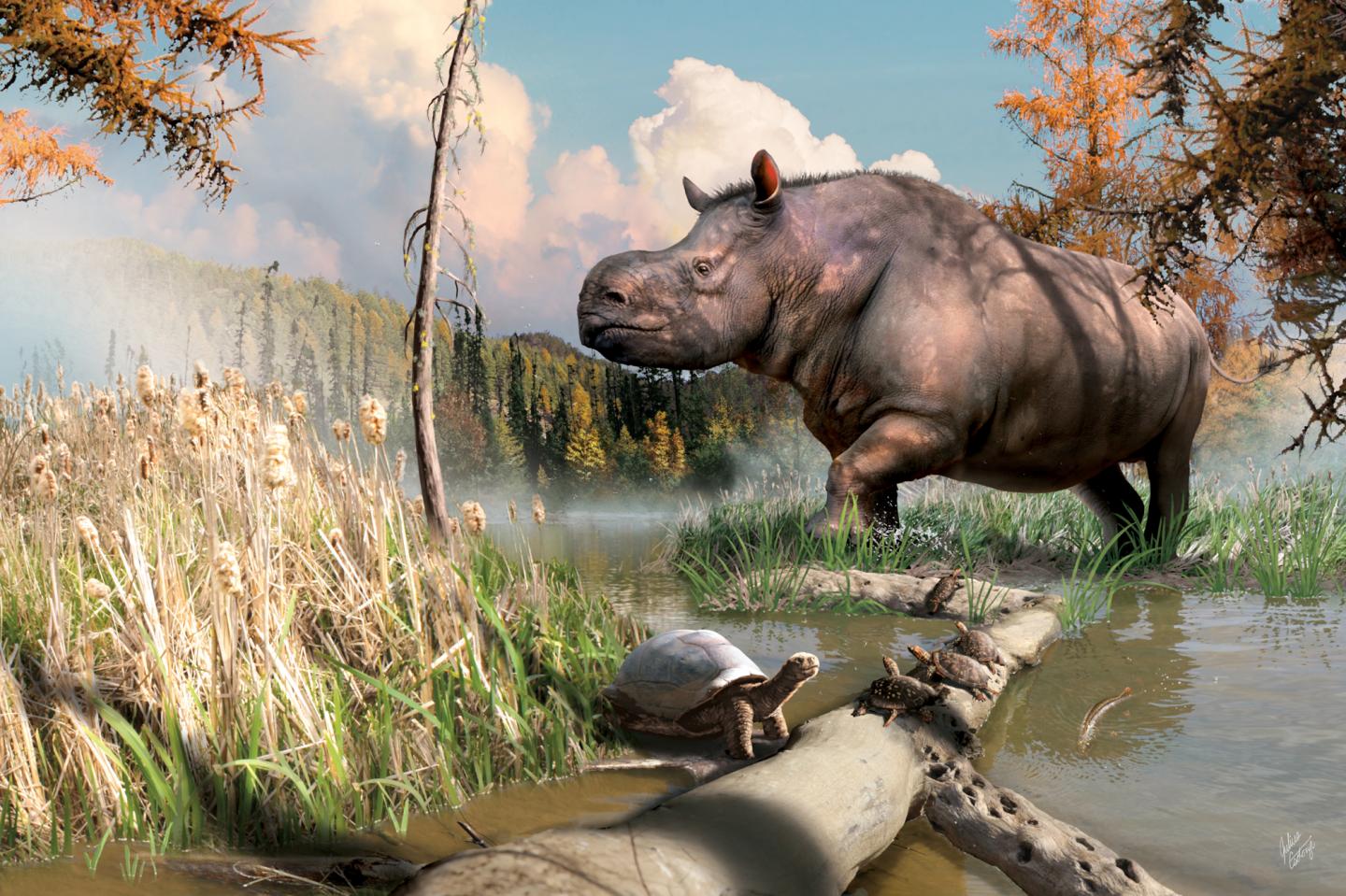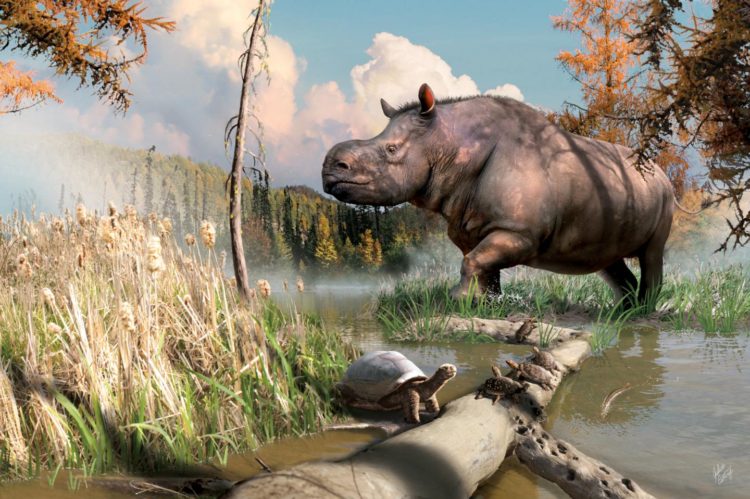
Credit: Julius Csotonyi
In 1973, a teacher named Joan Hodgins took her students on a hike near Whitehorse in Canada’s Yukon Territory. In the process, she made history for this chilly region.
While exploring the tailings left behind by a now-defunct copper mine, Hodgins and her students stumbled across a few fragments of fossils–bits and pieces of what seemed to be teeth alongside pieces of bone.
The ancient fragments of teeth were so small and in such bad shape that “most paleontologists may not have picked them up,” said Jaelyn Eberle, a curator of fossil vertebrates at the University of Colorado Boulder’s Museum of Natural History.
But Hodgins did. Now, more than 40 years after the teacher’s fateful hike, an international team led by Eberle used modern technology to identify the origins of those enigmatic fossils.
In a study published today, Eberle and her colleagues report that the fossil tooth fragments likely came from the jaw of a long-extinct cousin of today’s rhinoceroses. This hefty animal may have tromped through the forests of Northwest Canada roughly 8 to 9 million years ago.
And it’s a first: Before the rhino discovery, paleontologists had not found a single fossil vertebrate dating back to this time period in the Yukon.
“In the Yukon, we have truckloads of fossils from ice age mammals like woolly mammoths, ancient horses and ferocious lions,” said Grant Zazula, a coauthor of the new study and Yukon Government paleontologist. “But this is the first time we have any evidence for ancient mammals, like rhinos, that pre-date the ice age.”
It’s a gap in the fossil record that scientists have been keen to fill.
To understand why, imagine the Earth during the Tertiary Period, a span of time that began after the dinosaurs went extinct and ended about 2.6 million years ago. In that age, a land bridge called Beringia connected what are today Russia and Alaska.
Paleontologists believe that animals of all sorts, including mammoths and rhinos, poured over that bridge.
There’s just one problem: The geology and environment of the Yukon, which sat at the center of that mass migration route, isn’t conducive to preserving fossils from land animals.
“We know that a land bridge must have been in operation throughout much of the last 66 million years,” Eberle said. “The catch is finding fossils in the right place at the right time.”
In this case, the people at the right place and at the right time was a Yukon schoolteacher and her students.
When Eberle first saw Hodgins’ fossil teeth, now housed in the Yukon Government fossil collections in Whitehorse, she didn’t think she could do much with them.
Then she and her colleagues landed on an idea: Eberle put one of the small pieces under a tool called a scanning electron microscope that can reveal the structure of tooth enamel in incredible detail.
She explained that mammal teeth aren’t all built alike. The crystals that make up enamel can grow following different patterns in different types of animals, a bit like a dental fingerprint. The Yukon tooth enamel, the team found, carried the tell-tale signs of coming from a rhinoceros relative.
“I hadn’t thought that enamel could be so beautiful,” Eberle said.
The method isn’t detailed enough to determine the precise species of rhino. But, if this animal was anything like its contemporaries to the south, Eberle said, it may have been about the same size or smaller than today’s black rhinos and browsed on leaves for sustenance. It also probably didn’t have a horn on its snout.
The group also looked at a collection of fossils found alongside the rhino’s tooth chips. They belonged to two species of turtle, an ancient deer relative and a pike fish. The discovery of the turtles, in particular, indicated that the Yukon had a warmer and wetter climate than it does today.
Hodgins, now-retired, is excited to see what became of the fossils she and her students discovered more than 40 years ago: It’s “just so wonderful to learn what has developed with them from long ago,” she said.
Eberle added that the Yukon’s newly-discovered rhino residents are a testament to the importance of museums.
“The fact that these specimens were discovered in the Yukon museum collection makes me really want to spend more time in other collections, including at CU Boulder, looking for these kinds of discoveries that are there but haven’t had the right eyes on them yet,” Eberle said.
###
Coauthors on the study include Howard Hutchison of the University of California Museum of Paleontology; Kristen Kennedy of the Yukon Geological Survey; Wighart von Koenigswald of the Rheinische Friedrich-Wilhelms University in Germany; and Grant Zazula of the Yukon Paleontology Program in the Yukon Government.
Media Contact
Daniel Strain
[email protected]
303-735-5875
Original Source
https:/
Related Journal Article
http://dx.





